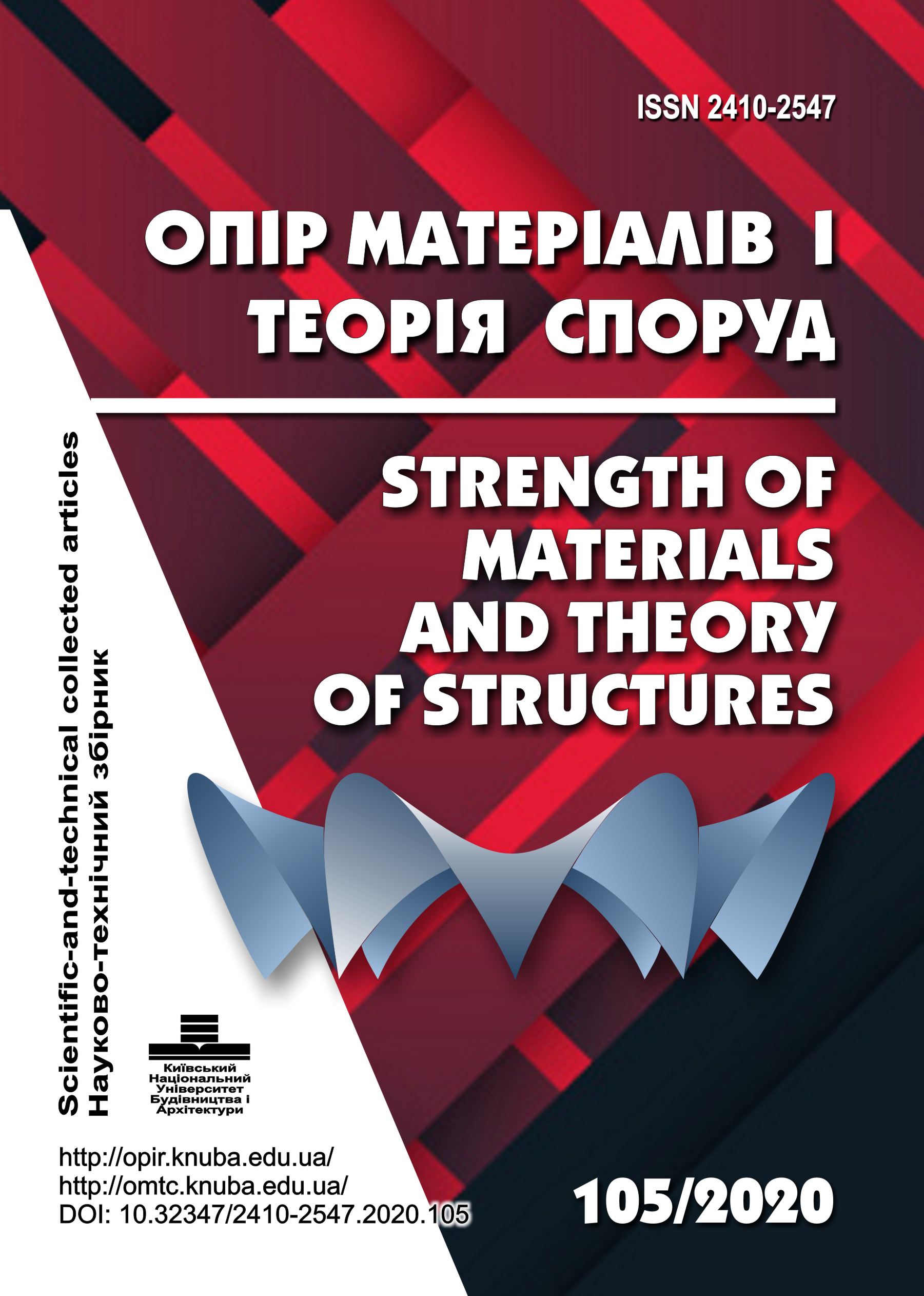Influence of air shock wane on buildings and structures
DOI:
https://doi.org/10.32347/2410-2547.2020.105.179-191Keywords:
air shock wave, dynamic load, reflection pressure, breach pressure, cover pressure, developed pressure, rupture timeAbstract
The destruction of buildings and structures occurs as a result of natural disasters, accidents, or terorist attactacts which in many cases are accompanied by explosions.
The action of an air shock wave on a building is characterized by a complex set of loads: excess pressure, reflection pressure, velocity pressure, leakage pressure, load from seismic waves.
Ensuring the preservation and restoration of buildings and structures includes measures to assess the possible degree of destruction of buildings and structures. Therefore, in modern conditions, the design of buildings, structures and their elements is not possible without taking into account the dynamic effects. When designing and constructing buildings and structures, it is always necessary to take into account the resistance of structural elements to the action of damaging factors, both the explosion in general and the shock wave of the explosion in particular, which will help avoid future possible human losses.
Therefore, the article considers the general characteristics of the processes of interaction of the air shock wave with the building, the method of calculating the time of destruction of prefabricated buildings and the main parameters of the air shock wave which flows as a result of an explosion in a building, structure with windows, doorways and openings, which arose as a result of the destruction of floor structures or walls.
Studies have shown that the load on the structure depends on the parameters of the wave that flows through the holes in the buildings and through the holes formed by the destruction of the walls of the building, the comparison of calculated and experimental data indicates their sufficient convergence.
References
Vasiychuk V.O. Osnovy tsyvilnoho zakhystu (Fundamentals of civil protection): Navch. posibnyk / V.O. Vasiychuk, V.Ye Honcharuk, S.I. Kachan, S.M. Mokhnyak - Lviv: Vydavnytstvo Natsionalnoho universytetu "Lvivska politekhnika", 2010.-417s. (in Ukrainian)
Bykova O.V. Boliyev O.V., Derevynskyy D.M., Yeliseyev V.N., Myronets S.M., Osypenko S.I., Piven YU.O. ta insh. Osnovy tsyvilnoho zakhystu (Fundamentals of civil protection): Navch. posibnyk K: 2008.– 223 s. (in Ukrainian)
Vasylchenko O.V. Budivelni konstruktsiyi ta yikh povedinka v umovakh nadzvychaynykh sytuatsiy (Building structures and their behavior in emergency situations): Navchalnyy posibnyk / O.V. Vasylchenko, YU.V. Kvitkovskyy, O.V. Myrhorod, O.A. Stelmakh. – Kharkiv: KHNADU, 2015. – 488s. (in Ukrainian)
Mkrtychev O.V. Raschet konstruktsiy zhelezobetonnogo zdaniya na vzryvnyye nagruzki v nelineynoy dinamicheskoy postanovke (Analysis of structures of a reinforced concrete building for explosive loads in a nonlinear dynamic setting)/ O.V. Mkrtychev, V.B. Dorozhinskiy, O.V. Lazarev // Vestnik MGSU. – 2011. – №4. – S. 243–247. (in Russian)
RD 03-409-01. Metodika otsenki posledstviy avariynykh vzryvov toplivno-vozdushnykh smesey (Methodology for assessing the consequences of emergency explosions of fuel-air mixtures). – M.: ZAO NTTS PB, 2014. – 38 s. (in Russian)
Chub I.A. Prohnozuvannya naslidkiv nadzvychaynoyi sytuatsiyi z vybukhom khmary hazopovitryanoyi sumishi (Forecasting the consequences of an emergency situation with the explosion of a cloud of gas-air mixture) / I.A. Chub, V.V. Matukhno // Problemy nadzvychaynykh sytuatsiy. – 2016. – Vyp. 23. – S.186-191. (in Ukrainian)
Rybakov A.V. Raschot ustoychivosti konstruktsiy zdaniy k udarno-volnovym nagruzkam (Calculation of the resistance of building structures to shock-wave loads)// Nauchnyye i obrazovatel'nyye problemy grazhdanskoy zashchity, № 4, 2013. S. 23–27. (in Russian)
Kobylkin I.F. Udarnyye i detonatsionnyye volny: Metody issledovaniya (Shock and Detonation Waves: Research Methods )/ [I.F. Kobylkin, V.V. Selivanov, V.S. Solov'yev, N.N. Sysoyev].–M.: Fizmatlit, 2004. – 375s. (in Russian)
Kvitkovskyy Yu.V. Vyznachennya parametriv udarnoyi khvyli, shcho utvoryuyetsya pid chas vybukhu hazopovitryanoyi sumishi (Determination of the parameters of the shock wave generated during the explosion of the gas-air mixture)/ Kvitkovskyy YU.V, Prokhach E.YU.// Zbirka naukovykh prats UTSZU. - №4, 2006. – S.120-124. (in Ukrainian)
Mukhin V.I., Rybakov A.V., Vil'danov R.R. O raschetnoy modeli otsenki porazhayushchego vozdeystviya vozdushnoy udarnoy volny ot obychnikh sredstv porazheniya (On a computational model for assessing the damaging effect of an air shock wave from conventional weapons)// Izvestiya Instituta inzhenernoy fiziki. 2017. №1, s. 58-63. (in Russian)
Nabiullin M.I. Matematicheskaya model' rascheta amplitudy izbytochnogo davleniya na fronte vozdushnoy udarnoy volny (Mathematical model for calculating the amplitude of excess pressure at the front of an air shock wave) / M.I. Nabiullin, A.V. Guseva, D. Yu. Verin, S.A. Vilokhin // Vestnik tekhnologicheskogo universiteta. 2017. T.20, №3 – S. 141-144. (in Russian)
Downloads
Published
Issue
Section
License
Copyright (c) 2020 Mykhailo Shyshanov, Volodymyr Маliuha, Volodymyr Koval, Volodymyr Mirnenko, Viktor Fil, Svitlana Hannenko, Roman Duzhyi

This work is licensed under a Creative Commons Attribution 4.0 International License.
Authors retain copyright and grant the journal right of first publication with the work simultaneously licensed under a Creative Commons Attribution License that allows others to share the work with an acknowledgement of the work's authorship and initial publication in this journal.

